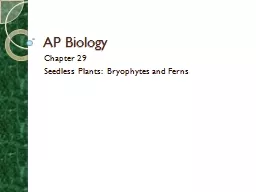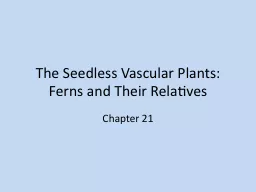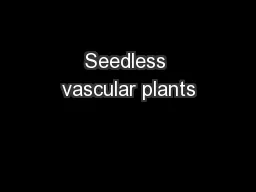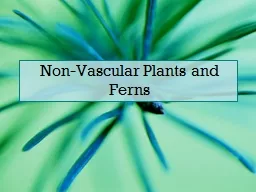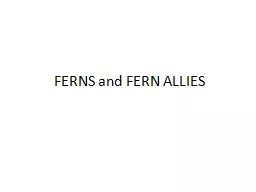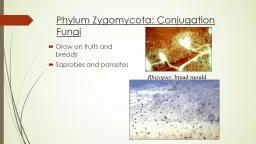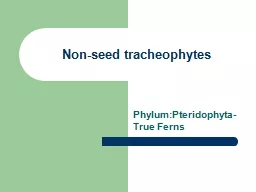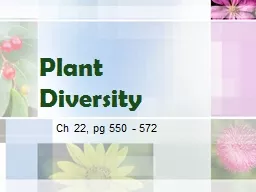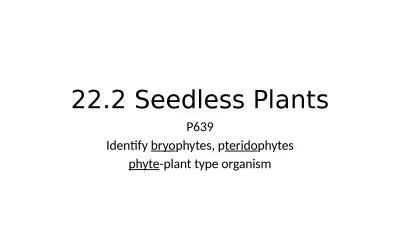PPT-AP Biology Chapter 29 Seedless Plants: Bryophytes and Ferns
Author : ellena-manuel | Published Date : 2018-09-25
Objectives 1 Name the protist group from which plants are hypothesized to have descended and describe supporting evidence 2 Discuss some environmental challenges
Presentation Embed Code
Download Presentation
Download Presentation The PPT/PDF document "AP Biology Chapter 29 Seedless Plants:..." is the property of its rightful owner. Permission is granted to download and print the materials on this website for personal, non-commercial use only, and to display it on your personal computer provided you do not modify the materials and that you retain all copyright notices contained in the materials. By downloading content from our website, you accept the terms of this agreement.
AP Biology Chapter 29 Seedless Plants: Bryophytes and Ferns: Transcript
Objectives 1 Name the protist group from which plants are hypothesized to have descended and describe supporting evidence 2 Discuss some environmental challenges of living on land and describe how several adaptations meet these challenges. Year . 7. 2015. Plants. Fungi. Monera. Protists. Plants. Plants are classified into two different phyla. The following characteristics determine where the plants fit. How they feed. Reproduction. Their physical features. Chapter 21. Outline. Introduction. Phylum . Psilotophyta. – The Whisk Ferns. Phylum . Lycophyta. – The Ground Pines, Spike Mosses and . Quillworts. Phylum . Equisetophyta. – The Horsetails and Scouring Rushes. Lecture. r: Asst. Prof. Dr. İsmail EKER. GENERAL CHARACTERISTICS OF. . SEEDLESS . VASCULAR PLANTS. There are two types of leaves that may be found on seedless vascular plants. Microphylls. Small and have a single vascular strand. Chapter 7: Section 2. Seedless Plants. How do seedless plants reproduce?. Include all nonvascular plants and some vascular plants. Vascular vs. nonvascular. Nonvascular plants do not have structures that transport substances through the plant. Evolution of Land Plants. Land plants evolved from green algae. The green algae called charophyceans are the closest relatives of land plants. Comparisons of both nuclear and chloroplast genes. Point to charophyceans as the closest living relatives of land plants. FERNS. Christmas Fern. Evergreen Wood Fern. FERNS. Ostrich Fern. Hay Scented Fern. FERN ALLIES. Horsetails. Club Mosses. Plants Vascular Plants Seed Gymnosperms Angiosperms Seedless (flowerless) Ferns Horsetails Club Mosses Nonvascular Plants Seedless (flowerless) Moss Liverworts and Hornworts Essential Question: Grow on fruits and breads. Saprobes and parasites. Rhizopus. : bread mould. Hyphae. Threadlike hyphae secrete enzymes which break down food. The hyphae then reabsorb the nutrients and transport them throughout the fungus by means of diffusion.. Outline. Research Question. Goals and Scope. Digitization Workflow. Geo-referencing. Dissemination. Outreach and Crowd Sourcing. Research Question. How are changes in distribution patterns of lichens and bryophytes over time correlated with man-made environmental changes?. From Last Day:. Closest Living Relatives of Land Plants - . Charophytes. Chara. . Coelochaete. Some . Charophytes. Typical . Charophyte. habitat. ?. Adaptations? - . sporopollenin. (polymer). Pollen grains – land plants. Phylum:Pteridophyta-True Ferns. Phylum: Pteridophytes -True Ferns…. Sporophyte . dominant and long-lived. Leaves are large, called . fronds. The following steles occur : . protostele. (all types) and . Chapter Overview. On to another kingdom!. Plants are familiar, but also far more complex than you think:. Inter-plant chemical warfare. Unusual plant-animal relationships . Surprising plant-weather relationships. Concept Test. : Reading evolutionary trees . Which of the plant groups contain the following traits: retention of embryo, stomata, vascular tissue, and true leaves? . liverworts, mosses, and hornworts. Identify . bryo. phytes, p. terido. phytes. phyte. -plant type organism. Green Algae. Q: What are the characteristics of green algae?. A: Green algae are mostly aquatic. They are found in fresh and salt water, and in some moist areas on land. .
Download Document
Here is the link to download the presentation.
"AP Biology Chapter 29 Seedless Plants: Bryophytes and Ferns"The content belongs to its owner. You may download and print it for personal use, without modification, and keep all copyright notices. By downloading, you agree to these terms.
Related Documents

